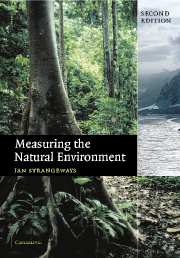Book contents
- Frontmatter
- Contents
- Acknowledgements
- 1 Basics
- 2 Radiation
- 3 Temperature
- 4 Humidity
- 5 Wind
- 6 Barometric pressure
- 7 Evaporation
- 8 Precipitation
- 9 Soil moisture and groundwater
- 10 Rivers and lakes
- 11 Data logging
- 12 Telemetry
- 13 Visibility
- 14 Clouds
- 15 Lightning
- 16 The upper atmosphere
- 17 The oceans
- 18 Cold regions
- 19 Remote sensing
- 20 Atmospheric composition
- 21 Forward look
- Appendix: abbreviations and acronyms
- Index
- References
9 - Soil moisture and groundwater
Published online by Cambridge University Press: 05 July 2014
- Frontmatter
- Contents
- Acknowledgements
- 1 Basics
- 2 Radiation
- 3 Temperature
- 4 Humidity
- 5 Wind
- 6 Barometric pressure
- 7 Evaporation
- 8 Precipitation
- 9 Soil moisture and groundwater
- 10 Rivers and lakes
- 11 Data logging
- 12 Telemetry
- 13 Visibility
- 14 Clouds
- 15 Lightning
- 16 The upper atmosphere
- 17 The oceans
- 18 Cold regions
- 19 Remote sensing
- 20 Atmospheric composition
- 21 Forward look
- Appendix: abbreviations and acronyms
- Index
- References
Summary
The cart-way of the village divides, in a remarkable manner, two very incongruous soils. To the south-west is a rank clay, that requires the labour of years to render it mellow; while the gardens to the north-east, and small enclosures behind, consist of a warm, forward, crumbling mould, called black malm, which seems highly saturated with vegetable and animal manure; and these may perhaps have been the original site of the town; while the woods and coverts might extend down to the opposite bank.
Gilbert White The Natural History of Selborne (published 1798).Subsurface water processes
Soil moisture
Soil moisture (or soil water) refers to the water that occupies the spaces between soil particles. It is at its maximum when the soil is saturated, that is when all the air between the particles is replaced by water but, if the soil can drain, the spaces will normally also contain air, the water then forming a thin film on and between the soil particles, held by capillary attraction. As the soil dries out this film becomes thinner and progressively less easy for plant roots to extract. The water is free to move through the soil, up or down, by gravity and by capillary attraction; it is taken up by plant roots, evaporates at the surface or recharges the groundwater.
- Type
- Chapter
- Information
- Measuring the Natural Environment , pp. 178 - 222Publisher: Cambridge University PressPrint publication year: 2003



